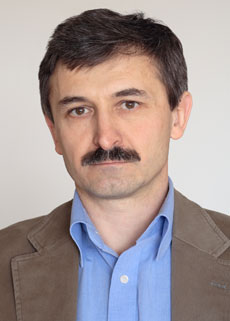
ATLAS e-News
23 February 2011
27 May 2008
Sergei Malyukov
Nationality: Russian

“Of course, at the very beginning, I had no idea how complex it would be. I think most people didn't. I thought it might take two or three years, but not almost six,” says Sergei Malyukov of the ATLAS cabling project which will finally reach its completion at the end of June. As Cabling Project Coordinator, Sergei has certainly had his hands full, both metaphorically and physically.
Now jointly employed by ATLAS and the Joint Institute for Nuclear Research (JINR) in Dubna, Russia, Sergei’s first contact with CERN was back in 1991, when he worked with the Omega Spectrometer. In 1995, he moved on to ATLAS to work with the TileCal group, researching the first TileCal prototype modules for the test beam, and testing the final modules. Following this, he joined a research and design team from Clermont-Ferrand University, France, working on detector control systems. During this time, Sergei spent several months per year in Clermont-Ferrand and on-site in Geneva, but he moved here full-time when he began work on the cabling project in August 2002.
“It was necessary for the cabling project to be under development right from the very early stages of ATLAS,” explains Sergei, who joined as part of the technical coordination group working on project development and cable installation, “but the intense stage only began in 2002.”
After collecting preliminary information on planned cabling from the various ATLAS detectors and subsystems, Sergei helped design an intricate plan for routing them. Working with CAD designers, he ensured that cable trays and patch panels were in place to take care of various combinations of pipes and lines.
As if 3,000 kilometres of cables weren’t enough to have to think about, Sergei and the team of designers also had to ensure that they left enough room for people to access the inside of the detector. “Inside ATLAS, there is not much space!” he laughs.
The installation of the cable trays began in 2003 in service caverns, ahead of the installation of the cables themselves, which began in May 2005. Following the successful completion of the calorimeter, inner detector, and muon system cabling, the last big stage – the small wheels – was completed at the end of April 2008. Once the remaining ongoing cabling tasks are completed, Sergei hopes to get involved with the driving of ATLAS itself:
“I’m a physicist, and as the installation of ATLAS is over, it is time to return to that really,” he says. “Like many other physicists, I have really enjoyed working on the construction side, though. It has been amazing seeing it all come together; less than three years ago, it was just a skeleton.”
In his free time, Sergei enjoys skiing in the winter, cycling in the summer, and photography all year round. Although he says there are differences in the cultures of Switzerland and Russia, he points out that the international, intergovernmental nature of both his two institutes mean that they don’t feel too different in essence:
“In terms of the spirit of physicists, it’s very similar. JINR is composed of 18 countries, so it feels sort of like CERN. In terms of life, life in Russia changes very fast,” he says. “Every year that I go back, things have changed and improved.”
